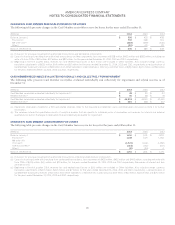American Express 2014 Annual Report Download - page 75
Download and view the complete annual report
Please find page 75 of the 2014 American Express annual report below. You can navigate through the pages in the report by either clicking on the pages listed below, or by using the keyword search tool below to find specific information within the annual report.AMERICAN EXPRESS COMPANY
NOTES TO CONSOLIDATED FINANCIAL STATEMENTS
NOTES TO CONSOLIDATED FINANCIAL STATEMENTS
NOTE 1
SUMMARY OF SIGNIFICANT ACCOUNTING POLICIES
THE COMPANY
American Express Company (the Company) is a global services company that provides customers with access to products, insights and
experiences that enrich lives and build business success. The Company’s principal products and services are charge and credit payment card
products and travel-related services offered to consumers and businesses around the world. After June 30, 2014, business travel-related
services are offered through the non-consolidated joint venture, American Express Global Business Travel (GBT JV). Until June 30, 2014, the
business travel operations were wholly owned. The Company also focuses on generating alternative sources of revenue on a global basis in
areas such as online and mobile payments and fee-based services. The Company’s various products and services are sold globally to diverse
customer groups, including consumers, small businesses, mid-sized companies and large corporations. These products and services are sold
through various channels, including direct mail, online applications, targeted direct and third-party sales forces and direct response
advertising.
PRINCIPLES OF CONSOLIDATION
The Consolidated Financial Statements of the Company are prepared in conformity with accounting principles generally accepted in the
United States of America (GAAP). Significant intercompany transactions are eliminated.
The Company consolidates entities in which it holds a “controlling financial interest.” For voting interest entities, the Company is
considered to hold a controlling financial interest when it is able to exercise control over the investees’ operating and financial decisions. For
variable interest entities (VIEs), it is considered to hold a controlling financial interest when it is determined to be the primary beneficiary. A
primary beneficiary is the party that has both: (1) the power to direct the activities that most significantly impact that entity’s economic
performance, and (2) the obligation to absorb losses of, or the right to receive benefits from, the VIE that could potentially be significant to
the VIE. The determination of whether an entity is a VIE is based on the amount and characteristics of the entity’s equity.
Entities in which the Company’s voting interest in common equity does not provide it with control, but allows the Company to exert
significant influence over the operating and financial decisions, are accounted for under the equity method. All other investments in equity
securities, to the extent that they are not considered marketable securities, are accounted for under the cost method.
FOREIGN CURRENCY
Assets and liabilities denominated in foreign currencies are translated into U.S. dollars based upon exchange rates prevailing at the end of
each year. The resulting translation adjustments, along with any relatedqualifyinghedgeandtaxeffects,areincludedinaccumulatedother
comprehensive income (loss) (AOCI), a component of shareholders’ equity. Translation adjustments, including qualifying hedge and tax
effects, are reclassified to earnings upon the sale or substantial liquidation of investments in foreign operations. Revenues and expenses are
translated at the average month-end exchange rates during the year. Gains and losses related to transactions in a currency other than the
functional currency, including operations outside the U.S. where the functional currency is the U.S. dollar, are reported net in the Company’s
Consolidated Statements of Income, in other non-interest revenue, interest income, interest expense, or other expenses, depending on the
nature of the activity. Net foreign currency transaction gains amounted to approximately $44 million, $108 million and $120 million in 2014,
2013 and 2012, respectively.
AMOUNTS BASED ON ESTIMATES AND ASSUMPTIONS
Accounting estimates are an integral part of the Consolidated Financial Statements. These estimates are based, in part, on management’s
assumptions concerning future events. Among the more significant assumptions are those that relate to reserves for Card Member losses on
loans and receivables, the proprietary point liability for Membership Rewards costs, fair value measurement, goodwill and income taxes.
These accounting estimates reflect the best judgment of management, but actual results could differ.
75
























